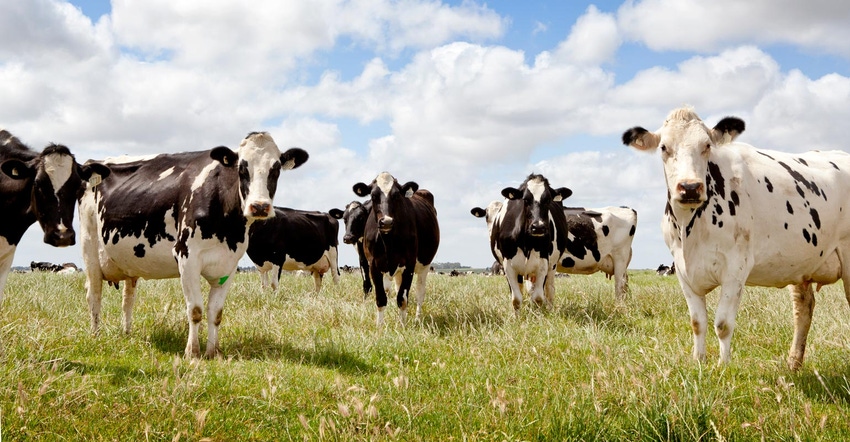
Dairy product prices and Class III milk prices are continuing to do the unexpected, according to Bob Cropp, University of Wisconsin-Madison Extension dairy economist.
“January forecasts called for 2020 to be a recovery year, with the best milk prices in five years,” Cropp says. “But the COVID-19 virus outbreak came along, resulting in a loss on milk and dairy product sales due to schools and universities closing, restaurants being shut down, and the cancellation of conferences and sporting events.”
By June, the demand for milk and dairy products improved, with restaurants partially reopening and needing to restock cheese and butter, people eating at home and significantly increasing store purchases of milk and dairy products, and the government buying a lot of dairy products — especially cheese.
Dairy exports jump
With dairy product prices below world prices, U.S. dairy exports increased. Dairy export volume in May was the highest it has been in more than two years, Cropp says. Nonfat dry milk-skim milk powder exports were the largest ever and were up 24% from a year ago.
“After running below year-ago levels, cheese exports in May were up 8%, the second-best month ever,” he notes. “May whey exports were 16% higher than a year ago.”
On the supply side, several dairy cooperatives implemented base excess plans to their dairy producers that reduced milk production. May milk production fell 0.5% below a year ago, according to USDA.
“With dairy product prices and milk prices being rather sensitive to small changes in demand and/or supply, dairy product prices improved beginning in May and in June, with cheese setting a record high in June,” Cropp says.
Average dairy product prices per pound for the month of June were $1.73 for butter, $2.34 for barrel cheese, $2.81 for 40-pound cheddar blocks, and $1.01 for nonfat dry milk. The price of dry whey was the exception, averaging lower than April at 32 cents. The June Class III milk price was $21.04, a record monthly increase of $8.90 from $12.14 in May.
Cheese prices continued to increase in July. Barrel cheese ranged from $2.37 to $2.45 per pound. Forty-pound cheddar blocks started July at $2.64 per pound and continued to climb, setting a record high on July 13 at $3 per pound.
However, as of July 22, the block price had fallen 37 cents per pound to $2.62. Barrels were $2.45 per pound. Butter prices moved up and down in July, starting the month at $1.75 per pound and falling to $1.67 by July 23.
“With these changes in July dairy product prices, Class III will be about $24.30, but will be below the record $24.60 set in September 2014,” Cropp says. “But the big question is, where are prices headed for the remainder of the year?”
Balancing supply and demand
Milk production needs to level off to keep milk prices from falling, Cropp says. “Milk production needs to stay well below a 1% increase over a year ago,” he explains. “After running well over 1% above a year ago, milk production fell 0.5% in May and was up just 0.5% in June. Since March, milk cow numbers have fallen each month and were down 35,000 head as of June.
“But June cow numbers were still 23,000 head higher than a year ago. Milk per cow has been running well below trend, with June up just 0.2% from a year ago.”
Sales of milk and dairy products have stayed below year-ago levels as restaurants and food service remain only partially reopened, according to USDA. The government will continue the Farm to Family Food Box program through Aug. 31. With the exception of butter, the price of cheese, nonfat dry milk and dry whey have been below world prices and are price-competitive. Dairy exports through May have been above year-ago levels, according to USDA.
“The price of cheese and nonfat dry milk moved above world prices in June and July, which likely slowed exports,” Cropp says. “The positive for dairy exports is milk production for major exporters is lower than a year ago, or only showing small increases, leaving an opportunity for U.S. exports.”
Not knowing when the COVID-19 virus will be under control, allowing more opening of restaurants, schools, colleges and other activities, makes milk prices uncertain, he says, because no one knows what dairy exports will do for the remainder of the year, nor the level of milk production.
“We should still see a seasonal increase in butter and cheese sales during the holidays, which will help hold prices,” Cropp says. “Also positive is that the stocks of butter and cheese, while still above year-ago levels, declined from May 31 to June 30.”
As of June 30, butter stocks were still 10.8% higher than a year ago, American cheese stocks were just 1.1% higher, and total cheese stocks were 2.6% higher than a year ago.
“It looks like the Class III price will trend lower in the months ahead but will not fall to low levels,” Cropp predicts.
Class III dairy futures remain quite optimistic, with Class III above $20 for August and September, in the $19s in October, and in the $18s in November before falling to $17 in December.
About the Author(s)
You May Also Like






